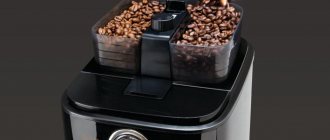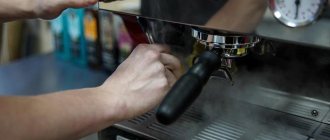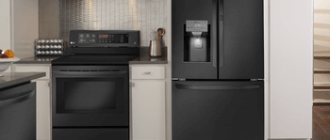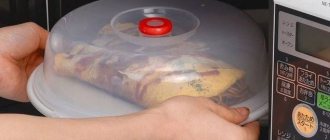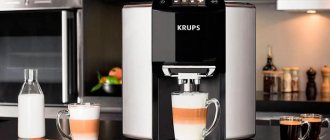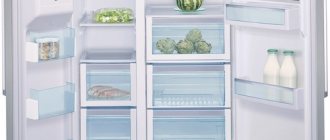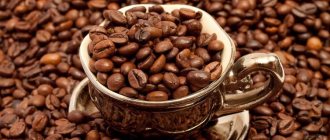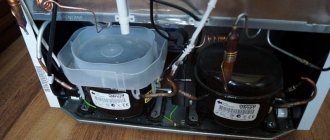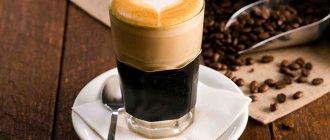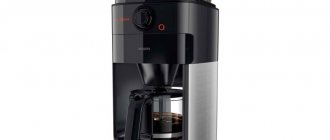Good coffee for a coffee machine - what is it?
Before you start choosing the coffee that is tailored to your machine, you need to answer the question of what type of coffee you want. Arabica, Robusta or Liberica? As you consider this, consider your expectations, including strength, taste, smell, color and density. Arabica has the least amount of caffeine, followed by Liberica and last is Robusta. Arabica has a noble and slightly sour taste. These differences are influenced by the following parameters: type, location and growing conditions, as well as the method of preparing the beans for use.
Coffee for the machine can be ground or beans. The one you need depends on your device. Automatic coffee grinder allows you to prepare a flavorful drink from freshly ground beans. When purchasing, pay attention to whether they are dark in color, as this is a guarantee of high quality. If you have a filter and want to use whole grains in it, you will need a coffee grinder. You can also buy ground coffee.
In the case of capsule coffee machines, there is no choice between ground and coffee beans; you also rely on the products offered by the machine manufacturer. However, each of them offers a wide choice. If your coffee machine doesn't have a built-in frother, you can usually buy milk capsules to make a cappuccino or latte macchiato.
Selection criteria: what to look for
To purchase the best bean coffee or ready-made blend for your coffee machine, you should pay attention to several characteristics of the finished product.
Roasting
The degree of roasting depends on the temperature at which it is produced.
It differs in different countries:
- Light, or Scandinavian (American) - with a slight sourness and chocolate flavor. It is not very popular in our country. To prepare it, you need to preheat the oven to 200–220°C. More often, Americano is prepared from such grains.
- Middle, or Viennese. The most common roast, producing a balanced taste, aroma and bitterness. Requires equipment heating up to 230°C. Best suited for brewing espresso.
- Dark, or French (240°C), Italian (245°C) or Spanish (250°C) with characteristic caramel notes and glossy, buttery grains. Freshly roasted coffee is used to make cappuccino or latte.
Freshness
The supply of raw materials from plantations to production sites occurs before the sale of coffee to the final buyer due to the fact that its shelf life begins from the moment of roasting. There is an opinion among gourmets that the drink should be brewed no later than 2 weeks from the date the beans were prepared. During this period, all the individual qualities of the drink are most clearly manifested. However, with the help of modern methods of vacuum packaging in foil, this period is extended.
Most often, a simple lover of an aromatic drink will not catch all the nuances of taste, so you need to highlight the following periods:
- up to 14 days – allows you to enjoy drinking coffee;
- up to 1 month – a good product for use in a coffee machine;
- from 2 to 4 months – will suit most consumers;
- up to 1 year – a suitable product, but it is no longer possible to grasp the characteristics of the variety.
All mixtures prepared more than 12 months ago are not recommended for purchase.
Grain size and shape
The long, large Arabica beans contain little caffeine, but the mixture is characterized by a rich flavor with many nuances.
More elongated Robusta seeds are bitter, but give an unsurpassed aroma, so they are contained in almost any mix.
Liberica is caffeine-free, with a large kernel and an odor that overpowers other varieties. The pure drink from this variety is bitter and watery.
Coffee type
The question of which type of coffee is best to choose for a coffee machine is decided by everyone depending on their own taste.
There are 3 types of grains grown in the world:
- Arabica, the oldest of all cultures, has a slight sourness, mild taste and delicate aroma. It contains up to 20% essential oils and up to 1.5% caffeine. The world market consists of 70% of grains of this variety.
- Robusta, which appeared in the Congo and prefers the plains. The drink has a sharp taste and slight bitterness.
- Liberica, cultivated in Malaysia.
For coffee makers, you need to choose a mix containing all types of kernels. Espresso blends include at least 10% robusta.
What types of coffee are suitable for espresso machines?
Arabica, Robusta and Liberica can be used with every type of espresso machine. It depends on the equipment whether it will be granular or ground. However, this does not mean that you have to have a more expensive automatic coffee machine. In the case of a cheap machine, it is recommended to grind the grain immediately before cooking. If you don't have time or don't want to buy a pack of ground beans from, for example, Nescafe, Cafe Mauro or Jacobsa, many of them are good quality Saeco espresso machine and DeLonghi espresso machine will make delicious coffee.
For brands that package whole grains, check out: Lavazza, Tchibo and Aroma Platinum . The most delicious drink will be prepared in espresso machines such as the Krups coffee machine and the Philips coffee machine . Try Arabica mixed with a small amount of Robusta; many gastronomic ratings (including well-known ones) indicate that this is an excellent solution. This way you will create excellent espresso and foam, on the basis of which you will prepare your favorite drinks - cappuccino, latte, mocha and many others.
Coffee producers
Everyone knows very well that there is no dispute about tastes. And what one person adore may disgust another. To find your ideal coffee option, you need to search and try. Moreover, there are so many alternatives offered that you can try something new every day.
Some manufacturers produce both grain and ground . These are the brands:
- Lavazza,
- Amado
- Cubita,
- Santo Domingo,
- Guantanamera,
- Illy,
- Musetti,
- Serrano,
- Danesi,
- Molinari.
Capsules should be selected based on the type of unit you have. Common capsule manufacturers are:
- Nescafe Dolce Gusto,
- Nespresso,
- Pellini,
- Tassimo,
- Molinari,
- Julius Meinl.
Coffee pods are less common than the previous ones, and therefore fewer companies produce them. Among the most famous:
- Danesi,
- Julius Meinl,
- Malongo.
These brands enjoy the well-deserved love of customers and have high ratings on coffee sales sites.
How much coffee does an espresso machine consume?
The amount of coffee in your cup depends primarily on the type of drink you're making and how strong you want it to be. Most coffee machines (for example, the Philips coffee machine) are equipped with the ability to prepare a certain type of drink in a stronger and weaker version. On average, one cup contains 8 grams of ground beans. This amount corresponds to a heaped teaspoon. Of course, this is not a rule, but an approximation. Depending on the type, capsules in a capsule machine may contain, for example, 7, 7.5 or only 8 g.
It's also worth considering how much grounds you can fit in the container - usually about 15 servings for household appliances. This is a manageable amount, meaning you won't have to clean up often. If we are dealing with larger equipment, then the container will even contain 40 or more servings. The instructions for your new kitchen gadget will tell you how much time you need to clean it. In addition, most equipment (including the Saeco coffee machine) is equipped with a display on which you will see a corresponding notification.
The best coffee brands for a pod coffee machine for 2021
The pods resemble tea bags. The rice paper body is easy to recycle. They come into contact with boiling water, a hot drink is released, which, depending on the quality of the machine, is close to a bar drink.
Before purchasing, you need to evaluate the shape that is suitable for the coffee machine. The market offers square bags (55 and 77 mm), trapezoidal, round and double round with a diameter of 38, 44, 55, 77 mm.
The advantage of pods compared to capsules is their price. The material that covers them is natural paper, and the capsule body is aluminum or plastic, so production costs for pods are lower and the equipment is simpler.
An important element is the amount of coffee contained in the bags. The correct dose for espresso is 7 grams. The most popular pods are marked ESE 44, since this is the volume they contain.
Kimbo
Kimbo Espresso Pods, Kimbo 100% Arabica, Kimbo Espresso Napoli - all these pods with the perfect amount of coffee. Packages of 100 and 200 pcs., pod weight 7 g. The company has long taken its rightful place in the market. The price in Russia is quite high. But consumers are satisfied with the quality; Kimbo is appreciated for the intensity of its aroma, while at the same time it is less concentrated compared to other brands. The appearance of the resulting drink is thick, creamy, chestnut in color, velvety in taste, and leaves a lasting aftertaste in the mouth. The brand has a special method of grinding beans; it contains no additives or preservatives. In addition, the pods are suitable for any coffee machine.
Kimbo Espresso Pods
Advantages:
- Well-deserved reputation;
- Special grinding technology;
- Good taste.
Flaws:
- Not identified.
Мalongo
The French brand is a significant competitor to Italian brands. Not only in pods, but also in beans, as well as ground coffee of excellent quality. Great attention is paid to the characteristics of raw materials; in recent years, the brand has been focusing on organic products and environmental protection. It's expensive, but consumers appreciate the innovation. Buyers note the deep rich taste and beautiful packaging. Tin cans with painting are suitable for gifts. Malongo pods have found their fans, since an individual standard portion is ideally designed for one cup. The brand offers different options: Grande Reserve, which has an alcoholic aftertaste, Colombia with fruity notes, Brasil with a strong aftertaste, etc.
Malongo pods
Advantages:
- Premium class;
- Rich flavors;
- A brand that keeps up with the times.
Flaws:
- Only for Nespresso machines.
Buscaglione
Buscaglione long pods are for connoisseurs of Americano or espresso-lungo. Buscaglione Arabica – with a fruity and floral delicate aftertaste. Buscaglione Decaffeinato is decaffeinated and Buscaglione Classico is a traditional recipe. An Italian manufacturer with a long family history, making coffee since 1899. Popular at home, less known abroad. The prices are not as high as other brands, but the quality is excellent. The drink is concentrated, forms good foam, and has a tart aftertaste. Therefore, consumers from Russia should take a closer look at the pods or bean coffee of this brand.
Buscaglione long pods
Advantages:
- Extensive offer in pods and beans;
- Pleasant value for money;
- The optimal combination of bitterness and sourness.
Flaws:
- Not identified.
How to grind coffee for a coffee machine?
If you have an automatic pressure coffee maker, the answer to the question is simple - there is no need to grind at all. Of course, the thickness of the ground beans isn't the same for every coffee drink, but the internal grinder is programmed to produce a liquid you'll actually enjoy. In the case of capsule coffee machines, the situation is somewhat different. Here you need to use a solution prepared by the manufacturer.
With a semi-automatic espresso machine, you program the individual grinder yourself, giving you more freedom. The beans should be medium or fine, but not too fine, as dust can clog the coffee filter and the crema will be too dark. A coarse grind, on the other hand, can result in poor brewing and too light or no foam. The best coffee grinders even have up to a dozen programs.
Whether you start every morning with a cup of aromatic brew or only enjoy it on vacation, choosing the right coffee should be a priority. Remember that with the right equipment at home, you are not reliant on just one type of black drink and have the freedom to experiment. Your guests will be delighted and will probably call you their home barista. Perfectly selected coffee and an excellent coffee machine are the key to success.
Have you ever wondered why some coffee beans can be smooth and sweet after brewing, while others can be expressive, spicy and bitter? The flavor contained in small grains depends on many factors. Find out the differences between the most popular types of coffee, which one to choose for your coffee machine, and what to do to make the perfect espresso.
How to choose the best bean coffee
Photo: https://pixabay.com/photos/coffee-cup-bean-coffee-bean-cup-5258877/
The taste and aroma of the finished coffee drink is influenced by a whole “bouquet” of factors: both major and minor. If you want to choose the best coffee beans that will definitely suit your taste, then get ready for a long (albeit pleasant, because you will need to sip more than one mug of coffee) hassle. What parameters should you pay attention to first?
- Type of grains. We have already talked about them above. Some prefer a drink made from 100% Arabica, others are inclined towards a blend, while others prefer robusta. In addition, there are options with a mixture of several varieties of Arabica or Robusta.
- Region of growth. The best Arabica grows in the highlands of Brazil, Kenya, Mexico, and Guatemala. Good quality beans from Ethiopia and Peru. The option of coffee from Vietnam and Indonesia is not excluded.
- Roasting degree. There is a certain pattern here: the darker the roast, the more bitter the finished drink will be, and the lighter the roast, the more clearly the sourness will appear. Medium level has a balanced taste.
- Cooking method. The packaging often indicates the preferred option for preparing the drink. But in most cases, the same coffee can be prepared in different ways: using a Turk, a coffee maker, a French press, a geyser coffee machine, etc.
- Packaging features. Yes, coffee beans last longer than ground coffee. However, if you keep the packaging open in a place where the product will be exposed to sunlight, then very soon it will deteriorate or become simply tasteless. The ideal option is a vacuum bag with a valve for gas exchange.
If you take into account all the above criteria, you will be able to choose the best coffee. That is, one whose taste and aroma will bring only positive emotions, and the drink itself will be charged with vigor and positivity.
The best coffee for an espresso machine - Arabica, Robusta or Liberica?
Where does coffee and its types come from? The path of aromatic grain leads from one of the countries lying in the so-called coffee strip, stretching between the tropics of Cancer and Capricorn. Coffee trees are delicate and require special care. It is in these places that they have the best conditions for growth and ripening: the temperature is constant, the sun is shining, and heavy rains moisten the fertile soil. Their development is also facilitated by the altitude above sea level. Any change in coffee growing conditions affects its quality and price.
The class and taste of coffee beans is influenced not only by the place and growing conditions, but also by the further path of the coffee tree fruit. The best and most expensive varieties are grown by hand, so their quality can be constantly monitored. This method is also much more delicate than that in which the grains are shaken from the branches or plucked with a comb. Full automation of coffee production is not recommended due to special care for the quality of each precious bean.
While Italy is considered by many to be the capital of coffee, home to the masters of brewing and serving, Brazil is the king of cultivation, followed by Vietnam, Colombia and Indonesia. Each establishment specializes in producing different types of coffee. This depends on the conditions in which the plants are grown. We can distinguish two main types: Arabica and Robust, as well as a mixture of Arabica and a slightly weaker quality Liberica. What is the difference?
Arabica or Robusta, what's the difference?
One of the fundamental characteristics is the ratio of Arabica to Robusta. These are different types of coffee beans.
Arabica gives almost all the flavor shades. Robusta – for richness, bitterness, strength.
The caffeine content in robusta is on average 2 times higher than in arabica. Robusta has no sourness. Robusta is also responsible for the height of the cream foam, so robusta is usually added to espresso mixtures - with it the foam is higher. I have specialized material about robusta.
Arabica can have many shades and facets, differences in the country of origin (terroir, climate in which coffee trees grow), processing of green beans, and roasting. By the way, who didn’t know, coffee is a berry. The higher the variety grows, the denser the grains, the richer the taste, the greater and more varied the sourness. By the way, sourness gives variation in taste, although in Russia, as a rule, they don’t like it.
100% Arabica means that there is relatively little caffeine in the mixture, but there is a lot of flavor variability. To highlight some specific shades (citrus, cocoa, floral notes) you need to switch to single varieties. What it is?
Monosort is grains collected in one country, on a specific territory, plantation. And therefore, in one more or less uniform climate with characteristic taste incarnations. Monosort, with rare exceptions, is only Arabica; the pack must contain beans from the same harvest.
For example, grains from Kenya, Ethiopia and Mexico have the greatest sourness. Soft berry sourness with a peppery hint from Jamaica. Brazil – roasted nuts and cocoa. Vietnam and Uganda – dark chocolate. Arabica beans from Cuba, the Dominican Republic and a separate variety from India, “Monsoon Malabar,” are considered the least acidic. In the latter, the sourness is literally “eroded” by the strong monsoon winds to which the coffee is exposed.
Personally, in the case of automatic coffee machines, I am more impressed by mixtures in the ratios 90/10 – 70/30. For espresso from carob coffee makers with single-bottom baskets, it is better to use 100% Arabica coffee. Funnels/Aeropress/drip coffee makers – also only Arabica.
There are also nuances in the grain size (screen), the initial quality of a specific green raw material (the number of defects per sample, “grade”), but this, as a rule, is no longer so relevant for buyers of automatic coffee machines (although it still has some impact on the taste in a cup) and is beyond the scope of this material.
If you want to buy a few different coffee blends immediately after purchasing a coffee machine in order to decide on “your” bean, then there used to be a good inexpensive option - take several packs of different blends from Lavazza. Lavazza Crema e Gusto is a composition of 30% Arabica and 70% Robusta, classic Italian espresso, with a strong bitterness, but for Russian tastes it can be bitter if you are not used to it. Crema e Aroma – a little “weaker” – 80/20. Caffe Espresso and Qualita Oro are different blends of pure Arabica. That is, with more sourness. But in recent years, Lavazza has seriously lost ground. In general, I personally consider all store-bought coffee to be second-class. I will repeat once again: you need to drink freshly roasted. However, among the store-bought and widely distributed brands they keep the Jardin brand (especially varieties with names for specific countries, such as Columbia Supreme), Paulig (exclusively for its promotional price, which tends to 600 rubles/kg), Julius Meinl, Bushido (this brand might even be in the big league of store-bought coffee, not far from Illy).
So, to understand your preferences as a first approximation - sour-balanced-bitter - it is better to take a sample set of different freshly roasted coffee. Such sample boxes are offered, for example, by Tasty Coffee, Bravos, Neva (in all cases the promo code 101KOFE , giving from 10 to 20% discount).
Recipe for “Italian espresso”: strong, invigorating, thermonuclear charge
By the way, if you don’t like bitterness (read: robusta), perhaps you just haven’t tried good blends with it.
Then, for an experiment, I can recommend buying Caffe Selezione Nobile Espresso from Saeco (well, not from them, of course, this is repackaged coffee under the Saeco brand from a small Italian factory). This is one of the striking examples of “factory” coffee, which on a home automatic coffee machine produces espresso, similar to the one that is loved and prepared in Italy itself using professional coffee horns. They respect mixtures with Robusta and know a lot about them (and know how to prepare them). The shop was closed, Saeco no longer supplies this coffee to us. Then another option is to try a good blend with Robusta. It’s not so easy to find a ready-made composition, so that they don’t skimp on robusta (well, that is, they don’t use the most shameful one), and Arabica without pronounced sourness, above-medium roast. Therefore, I can suggest making this mixture yourself:
- You buy 1 kilogram of a mixture codenamed “Black Candy” - 100% Arabica from Brazil and Colombia, dark roasted.
- Buy 250 grams of 100% robusta from Uganda.
- Pour everything into a large bowl, a plastic 5-liter bottle of clean water works well, close and mix evenly. As a result, you get a freshly roasted, balanced Italian-style blend of “80% Arabica + 20% Robusta.”
- It is better to set the grinding not to minimum (there will be too much bitterness), but closer to medium; I do not recommend pouring more than 30 ml. The temperature in all machines except Delonghi is the highest; in Delonghi it is better to cook on medium.
Arabica coffee beans
Arabica, which originates from Ethiopia, is the true king of coffee, considered to be the variety with the highest quality beans that produce an aromatic essence with a mild taste and thick consistency. Some gourmets are not irritated by its distinct notes of acidity and bitterness. It contains a small amount of caffeine, which helps reduce the resistance of the beans to diseases and pests for which this ingredient is poisonous. Due to the complex, labor-intensive cultivation and subsequent careful processing, it is more expensive than other types and is more in demand by connoisseurs. Arabica coffee grows on sunny slopes in subtropical or equatorial climates. They must be located at an altitude of 600 to 2000 m above sea level and exposed to a constant temperature that is in the range of 15-30 °C.
Arabica is recommended for gourmets who will appreciate its softness, aroma and density and do not need large doses of caffeine. They can choose from more than 20 varieties. One of the best and most expensive is Jamaica Blue Mountain , the plantation of which occupies only 7 hectares of the Blue Mountains range. It has the perfect balance between acidity and tenderness, as well as fruity notes.
Saeco
Italians are known for their love of espresso, and they understand quality coffee. One of the most famous Italian companies is Saeco. It produces coffee machines and bean coffee.
Saeco
Natural coffee Saeco Miscela Gold has a velvety taste and chocolate aroma, achieved through a wonderful combination of different varieties of Arabica grown on plantations in Brazil, Guatemala and Arabica. If you prepare it at home in a Saeco Miscela Gold coffee machine, the drink will be soft and aromatic with dense foam. Due to the fact that the mixture contains only Arabica, without Robusta, the coffee does not leave a bitter aftertaste. It contains a small percentage of caffeine, so the drink can be consumed even in the evening. One of the advantages of Saeco coffee is the absence of flavorings and a completely natural composition.
Robusta coffee beans
Robusta, which ranks second, has a lot of fans because it has a fairly high caffeine content. It protects coffee trees from pests and diseases, making the species more resilient and easier to propagate. Most often it is grown at an altitude of about 400-600 m above sea level. Robusta is recommended for anyone looking for a strong, spicy taste and a big dose of caffeine.
Why choose a coffee machine?
When choosing from the options: a Turkish coffee machine or a coffee machine, a modern person chooses the best unit with a maximum of functions and options.
After purchasing a machine designed for making coffee, the owner of the equipment asks the question: what kind of coffee is best for a coffee machine? There is a choice of what to use: Arabica and (or) Robusta.
If you analyze numerous reviews, you can see that the majority of users, based on their taste, express their preference for certain brands and varieties. When answering the question of which bean coffee is the best, the method of focusing on the opinion of a large mass of Internet users should be discarded, since everyone has different tastes. But you should listen to the opinion of experts on the question of which coffee beans are best for a coffee machine.
Liberica coffee beans
In addition to the two most popular varieties, Liberian coffee is also available on the market, which is grown on several plantations. Its breeding occupies about 1% of the market. Although it is rare, it is not overly expensive and is not prized by gourmets. It is often added to mixtures as a filler. After brewing, the essence does not acquire an intense taste and aroma. However, it is suitable for making low-caffeine coffee cocktails for people who do not like strong bitter infusions.
Coffee Jardin
According to many connoisseurs of the aromatic drink, Jardine is the best bean coffee for a coffee machine. It tempts with its affordable price and rich taste, which is why it occupies the first position in the rating. The production process of Jardin coffee takes place using modern technologies. In a protected environment, coffee beans undergo double roasting: drum and convection. This way the coffee beans are roasted evenly, and the coffee retains its quality and intense taste.
Coffee Jardin
Coffee Jardin in Russia is produced by a company located in St. Petersburg. She is the official representative of the Swiss company.
All Jardine coffee products are made exclusively from Arabica beans, which are harvested in Kenya and Colombia. The assortment of coffee includes both single-origin and high-quality blends. The buyer can purchase both ground and whole bean coffee.
What type of coffee is best for a coffee machine?
Coffee beans are best suited for espresso machines with a built-in grinder. They do not require the purchase of additional equipment, and the mechanical grinding of a small amount of coffee immediately before preparing the coffee guarantees its freshness and the highest quality. De'Longhi coffee machines allow you to choose the degree of coffee grinding to suit your taste.
When choosing coffee beans for an automatic coffee machine with a built-in grinder, the method of roasting the beans is also important. For this type of equipment, long burning at high temperatures that reach more than 200 ° C is recommended. Thanks to this, we obtain a rich, aromatic espresso - the basis for other coffee drinks - without sour notes. Connoisseurs prefer a brighter burning sensation, which preserves the richness of aromas: from chocolate, spicy-nutty, to fruity or citrus. However, this depends on personal preference. Information on how to roast the beans should be found on the coffee packaging.
It is also worth remembering that you should not put flavored beans in devices with a built-in coffee grinder. Essential oils released during grinding settle on the parts of the coffee machine and can damage it. Therefore, it is better to flavor your coffee after brewing with flavored syrups or natural spices intended for this purpose. However, if your favorite coffee is aromatic, choose De'Longhi semi-automatic or automatic coffee machines that are equipped to prepare ground coffee.
By degree of roasting
Different countries historically use different temperatures for roasting beans.
- Light
This type includes Scandinavian (200 – 210 ℃) and American (210 – 220 ℃), which are characterized by careful treatment of coffee beans. The drink made from such beans is highly sour, but you can fully capture all the nuances of single-origin beans: chocolate, spicy, nutty overtones. However, in Russia this category is not widespread precisely because of the acid.
- Average
It is also called Viennese (225 - 230 ℃). This is the most common roast level. It is most often used to prepare espresso blends. Gives the optimal combination of richness of taste, aroma and bitterness. You should start getting acquainted with the world of coffee with recipes like these.
- Dark
Differently - French (240 ℃), Italian (245 ℃) and Spanish (250 ℃). There is no sourness in the drink, only bitterness with caramel notes is felt. It is very important that the coffee is freshly roasted. This can be determined by its appearance: good grain will be oily and shiny.
The best coffee for a coffee machine
Semi-automatic coffee machines require you to pre-grind your coffee, but that doesn't mean you have to give up flavorful beans. To grind them, we can use an additional free-standing coffee grinder. It is worth paying attention to how much coffee we usually need to prepare our favorite drink, and not to grind the beans in advance. If they are left in the coffee grinder container, they quickly erode and lose their valuable aroma. You can also choose ready-made ground coffee in the store. In this case, carefully read the information from the manufacturer. The packaging should indicate whether the selected coffee is suitable for the machine and the grind level. This is important in the case of semi-automatic coffee machines that use filtration for brewing.
The best coffee brands for a capsule coffee machine for 2021
Coffee capsules are cylindrical containers containing a compressed powdered concentrated product inside. The advantage of this solution is storing coffee in a protective atmosphere so that the aroma does not dissipate.
Some have a polymer or plastic body, others are made of aluminum, or a combination. Any material keeps the coffee characteristics unchanged.
Popular new models: economical reusable capsules, as well as cardboard ones, which have minimal impact on the environment and are easy to recycle.
Reusable empty capsules Emohome Nespresso System (5 pcs.)
Made of plastic. Reusable capsules have thicker bottoms and walls. In addition, it is not possible to compact coffee in them at home as tightly as they do at the factory. Bottom line: the serving size is reduced by one or two grams, for some coffee lovers this is critical. Emohome produces packs of 5 and 10 pieces for Nespresso and Dolce Gusto systems. One capsule is enough for up to 10 uses.
Emohome Nespresso System Reusable Empty Capsules
Advantages:
- Convenience;
- Economical.
Flaws:
- An individual serving contains less than the standard amount of coffee.
What should you pay attention to? Capsule shape compatibility with coffee machine. It seems strange, but the machines do not work with the same type of capsules. For this reason, you should not buy the first capsules you come across; it will be unpleasant to encounter an incompatible object later.
The first thing that comes to mind is to choose packaging of the same brand as the coffee machine, but in this case the prices are “imposed” by the manufacturer. Often the cost is unattractive. It is better to choose other compatible brands that suit the price.
Borbone
Caffe Borbone capsules are the best-selling capsules; they have a good price/quality ratio. The more pieces, the more profitable. According to consumers, packs of 100 pieces are optimal; they do not require significant costs compared to other formats. Aluminum case, shelf life 24 months. The capsules are designed to be compatible with Lavazza machines as well as the Nespresso system. Coffee, sealed in capsules under the trade name Borbone Don Carlo, so-called “black”, with a strong but balanced taste, suitable for those who value intensity. At the same time, there is a creamy note, the taste seems more delicate.
Caffe Borbone capsules
Advantages:
- Rich shade and aroma;
- Economical price;
- The versatility of capsules;
- Reliable material.
Flaws:
- Difficult to find in Russia.
Nescafe Dolce Gusto
Nescafe Dolce Gusto offers coffee capsules for those who want to diversify their taste sensations and enjoy a drink other than espresso. For example, inside each Cortado Espresso Macchiato container is milk powder, creating a bar-style macchiato, a Spanish recipe with the creamy notes of cortado. The mixed flavor of almonds and pecans is highly prized, making it an unusual product. There are packs of 16 capsules each, and 48 capsules each, ideal for frequent consumption. Types of latte, cappuccino, and caramel are especially popular among consumers. Milk-free espresso capsules are also available.
Nescafe Dolce Gusto
Advantages:
- High quality raw materials;
- Convenient preparation;
- The ratio of coffee to milk is balanced.
Flaws:
- Some buyers think that the taste is too sweet. Subjective opinion is defined as a disadvantage because similar reviews are numerous.
Lavazza
Lavazza Blue Espresso intensive coffee capsules are expensive, but an ideal solution for those who do not trust other compatible capsules and want to use original ones. Available in 100, 200, 300 or 600 capsule packs, as well as single capsules to save money or try out a taste. The Blue Espresso line has a wide variety of flavors: Delicato (delicate), Dolce (sweet), Amabile (sweet, semi-sweet), Vigoroso (vigorous), Intenso (intense), Supremo (highest), Magnifico (magnificent), Deka (decaffeinated) etc. Consumers are satisfied that they are receiving an absolutely original product from a popular brand. Most people like the quality of the coffee, which has few competitors, so much so that many call it the best coffee capsules.
Lavazza Blue Espresso capsules
Advantages:
- Leading manufacturer;
- Blends and flavors for every taste;
- Decent organoleptic characteristics.
Flaws:
- More expensive than others;
- Compatible only with proprietary capsule coffee machine system.
Which coffee to choose for a filter coffee machine?
Filter coffee machines, like vending machines, use ground coffee or coffee capsules. Information about the method of roasting beans should be found on the coffee packaging. Those designed for filter coffee makers should spend less time at high temperatures and then cool down quickly.
How to adjust the flavor when making coffee
If, with the advent of an automatic machine for making cappuccino, moccocino or latte, you have a question about how to set up the device for a delicious result, then the following information is for you.
The quality of taste is affected by:
- type and grade of coffee beans loaded into the machine;
- the amount of oily and essential components in the grain;
- setting the gram (the amount of powder used to prepare a portion of the drink);
- the temperature of the water at which the drink is prepared;
- grinding setting;
- degree of water filtration;
By adjusting the indicators to the desired level, you will be able to get the best result.
Good coffee for the machine - types of coffee
The choice of coffee for the machine also depends on individual preferences. When purchasing, it is better to read the label carefully. The manufacturer must provide information about the place of origin of the beans, processing method, time and method of roasting. It's also worth considering his brewing recommendations. You can also find various markings on the packaging that will tell us what quality the selected type or mixture is.
The abbreviation AA or AAA and the words Excelso in Colombian coffee refer to larger beans with a more intense flavor. The designations HB, HG and especially SHB were adopted for species grown in the higher parts of the mountains. They are usually of higher quality and can be more expensive. If you are looking for something special, pay attention to the packaging with the slogan Supremo , dedicated to the best Colombian coffee.
Types and characteristics of coffee beans
The market offers an abundance of brand names of coffee beans for the coffee machine. There are more than 100 varieties of trees that produce coffee beans, but the most popular types are:
Arabica
The most famous variety. With a minimal proportion of caffeine in the composition, it gives a strong aroma, for which coffee lovers around the world give this variety high places in the rating of drinks.
It is important to follow the brewing technology when preparing Arabica, this is the only way the drink will have a beneficial effect on the body . Properly prepared coffee is guaranteed to boost your metabolism for the day, stimulate your brain and balance your emotional background.
Robusta
Robusta is noticeably different from the previous variety. The depth of the difference lies in the processing conditions of the grains, which gives Robusta a specific taste. In addition, the grains of both varieties also differ in composition, which determines the differences in aromas. Although Robusta is less “elite” than Arabica, an expensive package of these beans is still better than a cheap can of the latter.
Liberica
Liberica ranks third in global popularity. The variety is notable for its lighter taste than the previous 2 and its delicious, persistent aroma. With a minimal concentration of caffeine in the bean, Liberica is considered the most harmless variety. For some reasons, the variety is rarely exported, so it is found on store shelves only in those countries where it grows.
How to properly prepare coffee in a coffee machine?
Once you've chosen the perfect coffee that not only suits your tastes, but also suits your machine, ensure your espresso is of the highest quality. A lot depends on the grind. If you do it wrong, the effect you get will be far from what was intended. For this reason, many people prefer to buy already ground coffee. The problem will disappear if we buy a coffee machine with a built-in high-quality coffee grinder. It’s good if the coffee machine has the ability to individually select the degree of coffee grinding and obtain your favorite taste and texture.
How does grinding affect the quality of the drink? Too fine creates a burnt-out effect and makes the espresso bitter and spicy. If you use a too coarse grind, you end up with watered-down coffee with a thin beige foam that subsides after a while. Perfectly ground grains give a dark brown, irreplaceable infusion with a creamy, pleasant and very thick foam that remains on the surface for 4-5 minutes.
When making great coffee, you should also take care of how many degrees the brewing water will be. Coffee machines with a thermoblock not only work faster, but also allow you to get a constant desired temperature. This is 85-95 ° C. After all these conditions are met - which will be helped by a properly selected coffee machine - preparing the ideal drink will depend only on the choice of your favorite type of coffee.
By production date
Do you know that the lifespan of coffee begins from the moment it is roasted? That is why green grains are delivered from plantations to production sites, which are processed immediately before being sold to the end consumer.
Among true connoisseurs and connoisseurs, there is an opinion that freshly roasted coffee should be consumed within two weeks. After this period, he already loses his individuality and it is impossible to catch something “special” in him. But modern technologies come to the rescue: dark foil packaging, vacuum. All this significantly extends the storage period.
On average, the following periods can be distinguished:
- 2 – 3 weeks – grab this product and run quickly to enjoy a high-quality drink;
- 3 – 4 weeks – good coffee that has retained most of its properties;
- 4 – 8 weeks is a good option, from which you can still get an idea of the flavor nuances of the variety;
- up to 5 months – some nuances are still present, but the bulk of the invaluable character has already been lost;
- up to 1 year – a completely “edible” product, devoid of any individuality;
- more than 1 year - there is no point in buying expensive coffee with such a period, it is no different from cheap brands.
